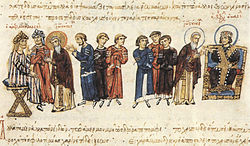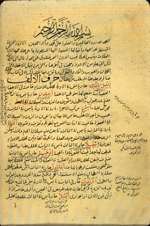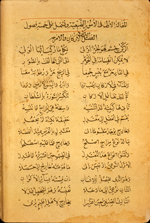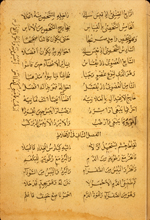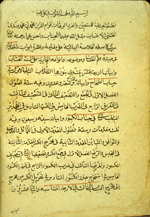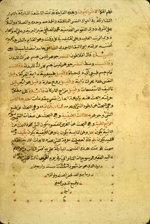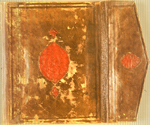Abdallah al-Mamun (786-833) was the seventh caliph, or ruler of
the Islamic Empire, of the Abbasid dynasty. During his reign he
encouraged the study of Greek thought, and the balance of power within
the caliphate shifted from the Arabs to the non-Arabs.
Al-Mamun was the son of Harun al-Rashid and a Persian slave girl, Marajil. Born about May 786, he was slightly older than his half brother Amin, son of the Arab Zubayda, but Amin was first heir to the caliphate and al-Mamun second. Al-Mamun, however, became governor of the eastern provinces, with Fadl ibn-Sahl as vizier. When Harun died in March 809, al-Mamun recognized Amin as caliph but kept his position in the eastern provinces. Tension between the half brothers led to war in 811, which ended in September 813 with the fall of Baghdad and the death of Amin.
Al-Mamun became caliph but continued to reside in the East despite disturbances in Iraq, Syria, and Egypt. In the struggle of rival interest groups, al-Mamun, hoping for wider support, in 817 designated as his successor Ali ar-Rida, head of the descendants of Ali, Mohammed's cousin. This step provoked a revolt in Baghdad, and Ibrahim, al-Mamun's uncle, was proclaimed caliph. Al-Mamun moved slowly back toward Iraq, entered Baghdad without difficulty, and ended the revolt (819). Ali ar-Rida had meanwhile died at Meshed.
For most of the rest of the reign there were disorders to be suppressed in various parts of the empire. Despite this fact, however, trade flourished, and the Abbasids were at the zenith of their prosperity. By 830 al-Mamun felt capable of mounting annual expeditions against the Byzantines. It was on one of these that he died in August 833 at Tarsus.
The interest in Greek philosophy is linked with the rise of the theological school of the Mutazilites. Nineteenth-century European scholars admired their apparent rationalism and liberal views, such as a belief in freedom of the will. It is now realized that, despite their interest in Greek ideas, they remained close to their Islamic basis. Several leading Mutazilites were prominent at al-Mamun's court, notably Thumama and Ahmad ibn-AbiDuad. Al-Mamun was probably attracted not only by the philosophical but also by the political aspect of their thought, for they were attempting to reconcile contemporary tensions. The stimulation of interest in Greek works influenced the whole subsequent course of Islamic thought.
In accordance with Mutazilite teaching, al-Mamun established toward the end of his reign (perhaps in 827) the Inquisition, or Mihna. All higher officials had publicly to profess that they believed the Koran to be the created, not the uncreated, speech of God. This was not mere theological hairsplitting but the basis of a hoped-for compromise between opposing forces. Most officials made the required declaration, but a leading jurist, Ahmad ibn-Hanbal, refused and was prevented from lecturing. The Inquisition lasted until about 850.

Al-Mamun was the son of Harun al-Rashid and a Persian slave girl, Marajil. Born about May 786, he was slightly older than his half brother Amin, son of the Arab Zubayda, but Amin was first heir to the caliphate and al-Mamun second. Al-Mamun, however, became governor of the eastern provinces, with Fadl ibn-Sahl as vizier. When Harun died in March 809, al-Mamun recognized Amin as caliph but kept his position in the eastern provinces. Tension between the half brothers led to war in 811, which ended in September 813 with the fall of Baghdad and the death of Amin.
Al-Mamun became caliph but continued to reside in the East despite disturbances in Iraq, Syria, and Egypt. In the struggle of rival interest groups, al-Mamun, hoping for wider support, in 817 designated as his successor Ali ar-Rida, head of the descendants of Ali, Mohammed's cousin. This step provoked a revolt in Baghdad, and Ibrahim, al-Mamun's uncle, was proclaimed caliph. Al-Mamun moved slowly back toward Iraq, entered Baghdad without difficulty, and ended the revolt (819). Ali ar-Rida had meanwhile died at Meshed.
For most of the rest of the reign there were disorders to be suppressed in various parts of the empire. Despite this fact, however, trade flourished, and the Abbasids were at the zenith of their prosperity. By 830 al-Mamun felt capable of mounting annual expeditions against the Byzantines. It was on one of these that he died in August 833 at Tarsus.
Development of Subject Dynasties
A significant development was the rise of a semi-independent hereditary dynasty under the caliph. A Persian general called Tahir played a large part in al-Mamun's success against his brother. After some time in the West, he was in 821 made governor of Khurasan, where there was serious trouble. Tahir gave signs of aiming at independence, and, when he died in 822, al-Mamun, who could not risk losing the province, appointed Tahir's son Talha to the governorship. One of Talha's brothers succeeded in 828. On the model of the Tahirids, independent dynasties, nominally appointed by and subordinate to the caliph, became a feature of the Islamic world, until the caliphs had no real power left.Interest in Greek Philosophy
Al-Mamun became an enthusiast for Greek thought and is credited with the foundation of the "House of Wisdom," an institute for translating foreign, especially Greek, books into Arabic. Translations had been made of Sanskrit and Persian works in the time of his great-grand-father and of Greek books in that of his father. Many Greek books were already extant in Iraq in Syriac translations, and most of the first translations into Arabic were made by Christians from these Syriac versions. The earliest interest of the Arabs was in astronomy (with astrology) and medicine, but Greek philosophy also attracted attention.The interest in Greek philosophy is linked with the rise of the theological school of the Mutazilites. Nineteenth-century European scholars admired their apparent rationalism and liberal views, such as a belief in freedom of the will. It is now realized that, despite their interest in Greek ideas, they remained close to their Islamic basis. Several leading Mutazilites were prominent at al-Mamun's court, notably Thumama and Ahmad ibn-AbiDuad. Al-Mamun was probably attracted not only by the philosophical but also by the political aspect of their thought, for they were attempting to reconcile contemporary tensions. The stimulation of interest in Greek works influenced the whole subsequent course of Islamic thought.
In accordance with Mutazilite teaching, al-Mamun established toward the end of his reign (perhaps in 827) the Inquisition, or Mihna. All higher officials had publicly to profess that they believed the Koran to be the created, not the uncreated, speech of God. This was not mere theological hairsplitting but the basis of a hoped-for compromise between opposing forces. Most officials made the required declaration, but a leading jurist, Ahmad ibn-Hanbal, refused and was prevented from lecturing. The Inquisition lasted until about 850.
Further Reading on Abdallah al-Mamun
There is no full-length study of al-Mamun in English, although there is a chapter on him in Philip K. Hitti, Makers of Arab History (1968). Walter M. Patton, Ahmed ibn Hanbal and the Mihna (1897), is concerned in part with the Inquisition under al-Mamun. He is mentioned briefly in general histories of the period.
Born: September 13, 786 AD, Baghdad, Iraq
Died: August 833 AD, Tarsus, Turkey
House: Abbasid Caliphate
Parents: Harun al-Rashid, Marajil
Siblings: Al-Mu'tasim, Al-Amin
Al-Muʿtaṣim, (born 794—died Jan. 5, 842), eighth ʿAbbāsid caliph, a younger son of Hārūn ar-Rashīd.Succeeding his brother al-Maʾmūn in 833, al-Muʿtaṣim was the first
caliph to employ the Turkish mercenaries who later came to dominate the ʿAbbāsid dynasty. In 837 he crushed a revolt of Persian schismatics led by the rebel Bābak,
who was cooperating with the Greeks. After the Byzantine emperor
Theophilus had laid waste the Muslim town of Zibaṭra (known to the
Byzantines as Sozopetra), al-Muʿtaṣim invaded Asia Minor, defeated
Theophilus, and destroyed the fortresses of Ancyra (Ankara) and Amorium
(August 838).
